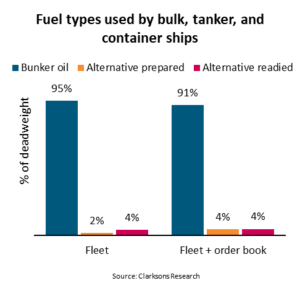“The International Maritime Organization’s (IMO) targets for the use of zero or near-zero fuels in 2030 can be met using sustainable biofuels. Many different sectors will compete for those fuels, so shipping is focusing on transitioning to alternative green and blue fuels. Today, only 1% of bulk, container, and tanker ships are prepared for using these fuels and fuel availability is low,” says Niels Rasmussen, Chief Shipping Analyst at BIMCO.
The IMO targets that near-zero greenhouse gas emission fuels shall represent at least 5% of the energy used by shipping in 2030, while striving to hit 10%.
The 1% of ships currently prepared to burn alternative fuels make up 2% of the fleet’s deadweight capacity. Another 1% of ships and 4% of deadweight capacity are readied for alternative fuels so they can more easily be retrofitted.
“However, 29% of the ships and 42% of the deadweight capacity in the order book are expected to be delivered prepared or readied for alternative fuels. Even if no existing ships are recycled, 4% of the fleet’s deadweight capacity will be prepared to burn alternative fuels once all the ships in the order book have been delivered in 2028. And another 4% will be readied for retrofit,” says Rasmussen.
As 1-2% of the fleet’s deadweight capacity is recycled every year, the share of the fleet’s deadweight capacity readied or prepared for alternative fuels will end higher by the 2030 deadline. It will be the older ships using bunker fuel that will be recycled, and more ships prepared for alternative fuels can be ordered, delivered or retrofitted before 2030.
With 5% of ships in the fleet and 55% of ships in the order book readied or prepared for alternative fuels, the container sector is expected to reach the highest share of alternative fuel use. Once the order book is delivered, at least 23% of the container fleet’s deadweight capacity will be readied or prepared for alternative fuels. The tanker fleet will reach at least 7% while the bulker fleet will reach at least 4%.
“So far, LNG has been shipping’s most popular alternative fuel, however, methanol and ammonia have been gaining popularity. Whether enough blue and green fuels will be available for shipping in 2030 has remained a question but with COP-28’s call for a tripling of renewable energy capacity by 2030, it now appears more likely that sufficient green and blue fuels can be produced to allow shipping to meet the 2030 targets – even without biofuels,” says Rasmussen.








